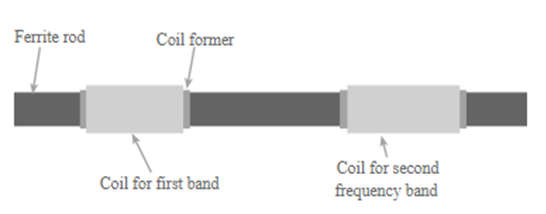- It is a small magnetic loop antenna used in AM broadcast transistor radios for medium & long waveband reception and RFID applications.
- The ferrite rod antenna is designed with a rod or bar made of ferrites and includes a coil wound around the ferrite rod with the help of a variable tuning capacitor in the radio circuitry.

- The antenna gives excellent results over shortwave frequencies when the antenna is made with a ferrite rod.
- To concentrate the magnetic field of the radio waves the core helps and gives out a stronger signal than a similar-sized air core antenna.
- Ferrod, ferrite rod aerial, or loop stick antenna is the other name for this antenna.
- In the above diagram, the ferrite rod antenna is identified as the inductor and core at the input of the circuit.
- The signal is passed through the transistor which acts as an RF amplifier, mixer, and also oscillator – forms the inductor assembly linking the emitter and collector.
- The tuning capacitor is mechanically connected with the RF antenna ferrite rod tuning.
- The signal reaches the IF transformer and the signal enters the IF or IF chain.
- By using the ferrite material the ferrite rod antenna operates to “concentrate” the magnetic component of the radio waves through the pick-up coil.
- This is conducted by the high permeability µ of the ferrite.
- It means that the ferrite rod antenna has a much greater level of sensitivity than if the coil had been used on its own.
Advantages of Ferrite Rod Antenna
- The ferrite rod antenna has a compact size.
- Increase its demand for RFID applications.
Applications of Ferrite Rod Antenna
- It is wireless applications in areas such as RFID.